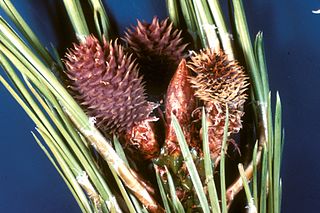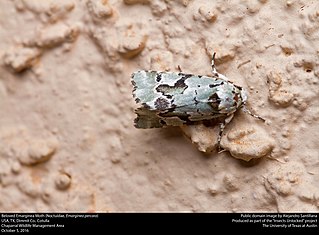Alexicles is a monotypic genus of tiger moth genus in the family Erebidae. Its only species, Alexicles aspersa, the Alexicles moth, is found in the US states of New Mexico and Arizona. Both the genus and species were first described by Augustus Radcliffe Grote in 1883.

Copivaleria is a monotypic moth genus of the family Noctuidae erected by Augustus Radcliffe Grote in 1883. Its only species, Copivaleria grotei, or Grote's sallow, was first described by Herbert Knowles Morrison in 1874. It is found in eastern North America, including Ontario, Tennessee, New York and Maryland.

Zanclognatha is a genus of litter moths of the family Erebidae. The genus was erected by Julius Lederer in 1857.

Mellilla is a monotypic moth genus in the family Geometridae erected by Augustus Radcliffe Grote in 1873. Its only species, Mellilla xanthometata, the orangewing moth, was first described by Francis Walker in 1862. It is found in most of eastern North America.
Paota is a monotypic moth genus in the family Geometridae described by George Duryea Hulst in 1896. Its only species, Paota fultaria, was first described by Augustus Radcliffe Grote in 1882. It is found in North America.

Phaeoura is a genus of moths in the family Geometridae.
Acronicta vulpina, the vulpina dagger moth or miller dagger moth, is a moth of the family Noctuidae. The species was first described by Augustus Radcliffe Grote in 1883. It is found in North America from New York and Newfoundland west to central British Columbia, south to Colorado.

Apamea plutonia, the dusky Quaker or dusky apamea, is a moth of the family Noctuidae. The species was first described by Augustus Radcliffe Grote in 1883. It is native to northern North America, where it occurs across the boreal regions, with some occurrences from as far south as New Mexico and Pennsylvania.

Caenurgina caerulea, the cerulean looper moth, is a moth of the family Erebidae. It is found in large parts of North America, including California, and British Columbia.
Drasteria pallescens, the cowhead arches, is a moth of the family Erebidae. The species was first described by Augustus Radcliffe Grote and Coleman Townsend Robinson in 1866. It is found in North America from Alberta and Saskatchewan south to Texas and Baja California.

Gnophaela vermiculata, the police-car moth or green lattice, is a moth of the family Erebidae. The species was first described by Augustus Radcliffe Grote in 1864. It is found in the western parts of North America, from British Columbia to California, east to New Mexico and north to Manitoba.

Dioryctria auranticella, the ponderosa pineconeworm moth, is a moth of the family Pyralidae. The species was first described by Augustus Radcliffe Grote in 1883. It is found in western North America from southern British Columbia south to California and Arizona, east to South Dakota and New Mexico.

Phaeoura quernaria, the oak beauty, is a moth of the family Geometridae. The species was first described by James Edward Smith in 1797. It is found in eastern North America, occurring as far west as east-central Alberta. The habitat consists of aspen-cherry shrubland.
Inopsis funerea is a moth of the family Erebidae. It was described by Augustus Radcliffe Grote in 1883. It is found in North America, where it has been recorded from Arizona and South Carolina.
Evergestis obliqualis is a moth in the family Crambidae. It was described by Augustus Radcliffe Grote in 1883. It is found in North America, where it has been recorded from Arizona, California, Colorado, New Mexico, Texas and Utah.
Prosoparia perfuscaria, the inornate prosoparia moth, is a moth in the family Erebidae described by Augustus Radcliffe Grote in 1883. It is found in North America.
Phaeoura perfidaria is a species of moth in the family Geometridae. It was described by William Barnes and James Halliday McDunnough in 1917 and is found in North America, where it has been recorded from Arizona, California, Colorado and New Mexico.
Stiriini is a tribe of owlet moths in the family Noctuidae. There are at least 120 described species in Stiriini.

Psaphidini is a tribe of owlet moths in the family Noctuidae. There are at least 40 genera and at least 90 described species in Psaphidini.
Phaeoura cristifera is a species of geometrid moth in the family Geometridae. It is found in North America.







